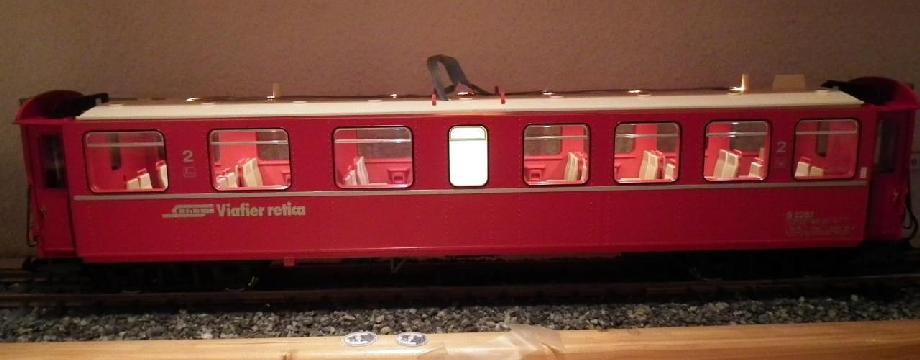Katzhagen modeling department
RhB B 2282
A visit to my favourite model train dealer brought me a markedly nice increase of the rolling stock, more or less unexpected. While I wasn't impressed too much by catalogue pictures of the RhB steel coach in the past, this changed immediately when holding the model in my hands. Want have !
In order to reduce the rolling resistance and to improve the power pick up
the car was equipped with 4
Magnus RhB ball bearing axles (see image on
the right). These had proven their worth with other models more than once.
Regarding the car's illumination one has to admit that the manufacturer tried to do its best and that the related results are well done, it f.i. features a socket for plugging in a decoder. Unfortunately, one apparently forgot there are still analogue layouts, on which the illumination is hardly visible below 8V. Furthermore the interior's illumination is lacking both a uniformity and sufficient brightness. Three bulbs only seem to be quite an understatement.
Having Hobson's choice, the ex-factory illumination gear had to be removed...
Regarding the car's illumination one has to admit that the manufacturer tried to do its best and that the related results are well done, it f.i. features a socket for plugging in a decoder. Unfortunately, one apparently forgot there are still analogue layouts, on which the illumination is hardly visible below 8V. Furthermore the interior's illumination is lacking both a uniformity and sufficient brightness. Three bulbs only seem to be quite an understatement.
Having Hobson's choice, the ex-factory illumination gear had to be removed...

The ex-factory axles were replaced with Magnus ball bearing axles
First the original illumination consisting of a printed board holding three bulbs and the fiber-optic light guides were removed. Move the mouse pointer onto the image to see the original state:
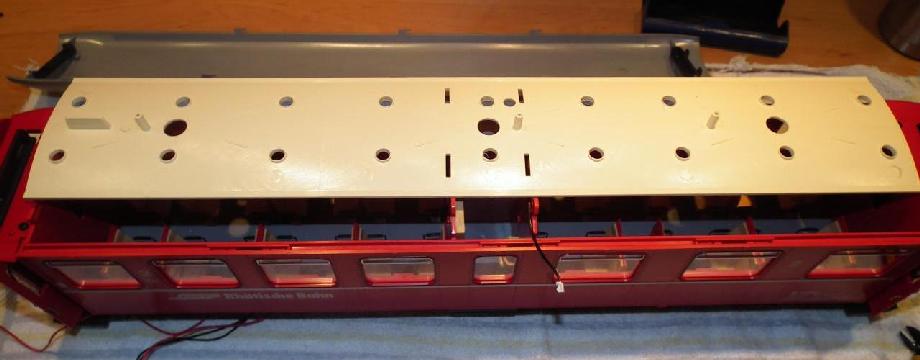
Next the wholes in the ceiling were filled with a methacrylic two-component adhesive (Stabilit Express) and warm white LEDs were installed:

The ceiling's upper side: Filled holes and ribbon cable with LEDs soldered to it which where glued in place before.

The ceiling's inner side: Filled and colour-coordinated holes as well as LEDs for the new illumination.
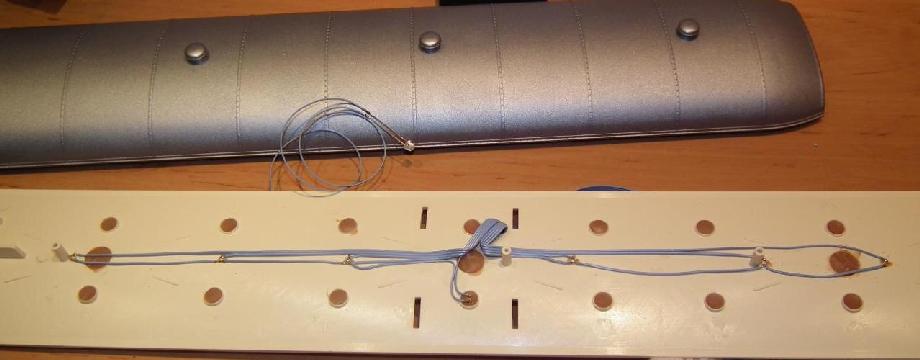
The modified ceiling's upper side featuring 7 LEDs and the wiring made from ribbon cable. The toilet's illumination wasn't done via the roof - see below.


In order to replace the ex-factory board a new circuit board was made to
provide power to the new 7 LEDs in the car's ceiling and the toilet's
illumination - its current control provides for full brightness at just 3V.
A timer on the new board drives the toilet's light which results in a nice
and effective toggling between on and off of the light automatically.
The picture on the right shows the ribbon cable of the ceiling's illu with its
plug.

The toilet's walls were equipped with a white self-adhesive film for an improved illumination uniformity. SIL socket bar for the ceiling's illumination.

The new board in place of the previously removed one. Move the mouse pointer onto the picture showing the board to reveal the ex-factory state.

The coach equipped with its new illumination. The efforts taken were rewarded
with a considerably higher illumination uniformity and a brighter light. Also
all of the interior's details are clearly visible now.
The model needs to be disassembled to some extent in order to do the colour corrections precisely. Thanks to the well-thought contruction, this is done quite easily. The interior's design came into focus first and the compartment's walls in the middle were removed after gently pushing the long side walls a little apart. After that, the interior side walls can be pulled out.
Play of colours
The manufacturer took great care in implementing numerous details which do bear a lot of potential for colouring them according to the prototype.The model needs to be disassembled to some extent in order to do the colour corrections precisely. Thanks to the well-thought contruction, this is done quite easily. The interior's design came into focus first and the compartment's walls in the middle were removed after gently pushing the long side walls a little apart. After that, the interior side walls can be pulled out.
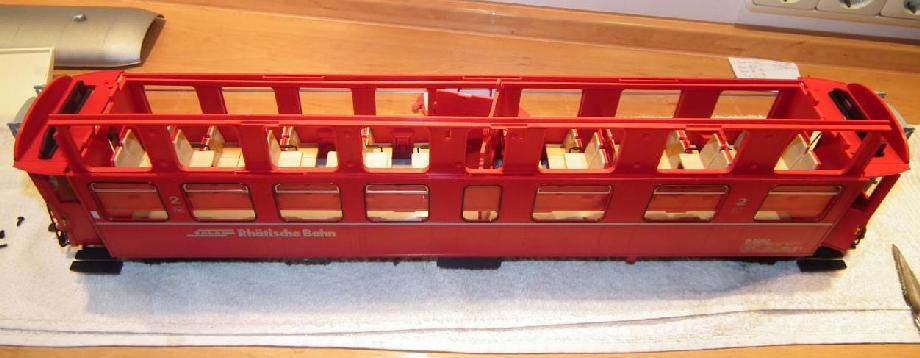
Taking out a side wall's inner part - the long side walls need to be pushed apart a bit to remove the walls of the compartments in the middle.


After removing the side walls the seats need to be removed from them for a better access to the details to be masked first and then painted. The bars below the windows, the ashtrays and the wastebaskets get an aluminum paint while the oddments trays are painted with the same colour the seats are (see below).
Both the control cabinet doors' hinges and the compartment doors' strike plates also get an aluminum paint. Gauges like Ampere- and Voltmeters are applied to the control cabinet - related pictures were found on the 'Net which were printed to fit and glued in place (see image on the left).
The little daubing's result inside the cabin:
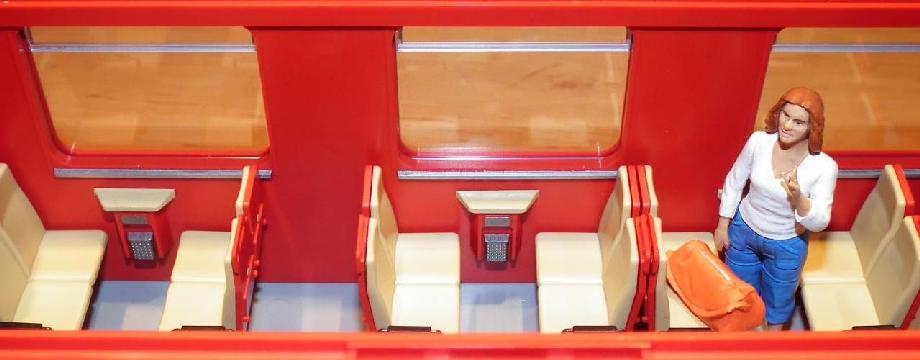
Small changes - fairly effective impacts. Move the mouse pointer onto the picture to view the effect.
More efforts
are required to apply the colour corrections to the car's exterior details. Numerous small parts need to be dismounted, partially masked and all of them do need three paints (being exposed to a higher encroachment than the interior parts) being applied with an airbrush gun: Primer, the desired colour and a clear coat (all from Revell) as a sealing.
The car's face side after removing the small parts

Ten small parts per face side need to be painted

Small parts prepared for applying the basic colour

Only the part of the bellows mounted directly to the car is being painted red

The pictures above and on the right show the little changes which result in a remarkably different impression which does not only look more prototypical. On positioning your mouse pointer onto the pictures, the ex-factory state will be revealed.

The model after its metamorphosis. It really looks extarordinary good now together with the old ABe 4/4 and the open-air coaches. This car isn't really used in operations on the Bernina line but it has been in the workshop at Poschiavo for a revision and thus this train is not pure fantasy, fortunately.

